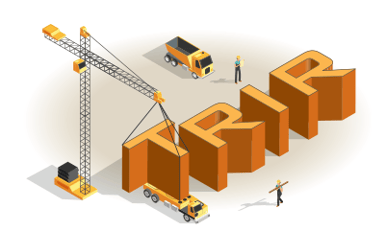Articles | Safety & Regulations
Why Is TRIR Important - What's RedGuard's Safety Rating in 2024?


This blog post was originally published in 2018 but has been updated with current numbers.
Explaining TRIR and Why It's Important
At RedGuard, we take safety seriously, even down to saying that safety is in our culture. One of the ways we measure that is our TRIR, or Total Recordable Incident Rate.
 As a manufacturer of blast-resistant buildings, it makes sense that knowing our safety rating would also be important to our customers. After all, if a company won't share their safety rating and they make a product designed to keep you safe, you're already starting on the wrong foot. So, as you can imagine, "What's RedGuard's safety rating?" is a question our team gets asked fairly often. Here's how we approach that.
As a manufacturer of blast-resistant buildings, it makes sense that knowing our safety rating would also be important to our customers. After all, if a company won't share their safety rating and they make a product designed to keep you safe, you're already starting on the wrong foot. So, as you can imagine, "What's RedGuard's safety rating?" is a question our team gets asked fairly often. Here's how we approach that.
OSHA AND TRIR?
OSHA, or the Occupational Safety and Health Administration developed the TRIR formula. It is a calculation used across all industries for record-keeping purposes.
To understand what that means and the impact it can have on our employees and business, let's examine how it works. The TRIR calculation begins when an OSHA Recordable injury occurs, so if your company had no injuries on the job, your TRIR would be 0.00. An OSHA recordable injury or illness is defined as a work-related injury that requires medical treatment beyond first aid.
The TRIR formula:
Total number of recordable injuries/illnesses X 200,000, divided by the total hours worked during the year. The number 200,000 is derived from:
100 employees, working 40 hours a week, for 50 weeks.
As an example, the RedGuard TRIR formula for 2022 is:
4 X 200,000, divided by 625,137 = 1.28.
The number 4 above would mean that for every 100 employees, 4 employees had a recordable injury or illness.
It is important to note that this formula punishes small employers because they do not work enough man-hours to establish and maintain a low TRIR, even with few injuries. For example, again, looking at RedGuard, but in two separate years with a disparate number of employees:
2012 - 2 injuries, 70 employees, and 169,000 hours = 2.36 TRIR.
2014 – 2 injuries, 276 employees and 663,000 hours = 0.60 TRIR.
Why DOES OSHA CONSIDER TRIR Important?
Although the TRIR is a lagging indicator, the primary value is to evaluate and quantify a company’s safety performance, both internally and externally. TRIR ratings that approach or exceed the industry average can also trigger OSHA inspections, which can be comprehensive. All clients require a three-year average so that they can see trends in their contractor’s safety programs.
2015 TRIR – 1.52 – 5 Injuries
2016 TRIR – 1.51 – 4 Injuries
2017 TRIR – 1.65 – 3 Injuries
Those numbers put the three-year average for those years at 1.56 (12 injuries). Our current three-year average is 0.93
Many RedGuard clients hold us to a TRIR of < 1.5 and a few hold us to < 1.0. If we are at (or above) these thresholds, at least three things can happen:
- We can’t bid, so we don't get the business
- We can’t enter the site to perform work; we can only supervise
- We are not permitted on-site
What is the RedGuard TRIR and TRIR Goal?
RedGuard 2024 TRIR - 1.2 [Year to date]
U.S. Industry Avg. – 5.6
We keep our TRIR goal below the number that any clients require, at 0.9.
What About Other Metrics?
In addition to TRIR, our EMR goal, or Experience Modification Rate, is also 0.9. We're currently at 0.64 year to date, lower than last year's 0.67. EMR has a substantial impact on a business because it is a number used by insurance companies to gauge both the past cost of injuries and the future chances of risk. The lower the EMR number, the lower the workers' compensation insurance premiums. An EMR of 1.0 is considered the industry average. Our low EMR rate of 0.67 saves us considerably on our annual worker's compensation insurance premiums.
How does the TRIR fit into the RedGuard Culture?
 The TRIR reflects a company’s core values, culture, and the employer’s commitment to that culture. There are a few things that either a low or high TRIR should clue you in on.
The TRIR reflects a company’s core values, culture, and the employer’s commitment to that culture. There are a few things that either a low or high TRIR should clue you in on.
A high TRIR could be an indication of:
- No, or very low safety culture and ownership
- No safety commitment from management or employees
- OSHA visits with thousands, if not tens of thousands of dollars, in fines
- Increased injuries, workers' compensation claims, and settlements
- Paying >10% higher workers' compensation premiums
- OSHA violations remain on record/ISN, Avetta, etc., for five years
- Ineligible to apply for SHARP Certification (OSHA Safety and Health Achievement Recognition Program) or VPP Certification (Voluntary Protection Program)
- Low morale, low engagement, zero recognition, and no job satisfaction
RedGuard's OSHA TRIR, Which is Low, indicates:
- High value on safety culture and ownership
- Safety commitment from the top-down and the bottom-up
- Only random OSHA visits for special emphasis
- Lower worker's compensation insurance premiums (2021 – 22% savings)
- No OSHA violations
- Eligible to apply for SHARP or VPP Certification
- High morale, high engagement, recognition, and job satisfaction
So You Know RedGuard's TRIR - What Next?
If you're searching for a safety-related product, especially something as high profile as a blast-resistant building, we encourage you to inquire about the company's safety rating. Take into consideration all of the factors above. If the rating isn't a TRIR but some other indicator, be sure to ask what elements are used to create that rating.
So if you're wondering what to look for in a BRB, it's important to remember that not all BRBs are created equal.
If you have any questions about TRIR, we invite you to schedule a quick consultation with one of our industry specialists.
Carreen Gibbons
Carreen Gibbons is the Communications Specialist at RedGuard. With a natural curiosity toward technical subjects and a love of learning new things, she writes content for the SiteBox Storage and RedGuard websites and spends her days learning new things about the industries that the companies serve.

